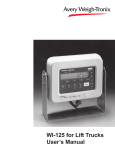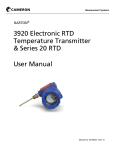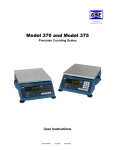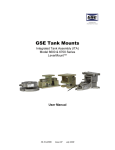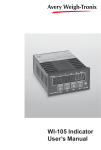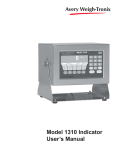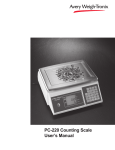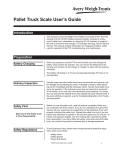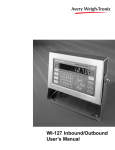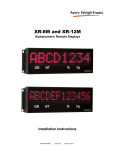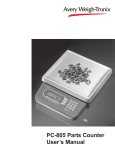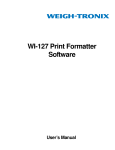Download WI-150 Ultra Low-Power Weight Indicator User`s Manual
Transcript
WI-150 Ultra Low-Power Weight Indicator User’s Manual EUROPEAN COUNTRIES WARNING This is a Class A product. In a domestic environment this product may cause radio interference in which the user may be required to take adequate measures. CAUTION Risk of electrical shock. Do not remove cover. No user serviceable parts inside. Refer servicing to qualified service personnel. Weigh-Tronix reserves the right to change specifications at any time. 12/13/04 150_U.P65 PN 29533-0013K e1 Printed in USA 2 WI-150 Ultra Low-Power Weight Indicator User's Manual Table of Contents Introduction .................................................................................... 7 Operations Mode ........................................................................... 7 Keyboard ....................................................................................... 8 Indicator Operation ........................................................................ 9 Powering Up ....................................................................... 9 Annunciators ..................................................................... 10 Operations Mode .............................................................. 10 Gross/Tare/Net Weighing Operations .................... 11 Gross Weighing .................................................. 11 Net Weighing ...................................................... 12 Pushbutton Tare ............................................. 12 Clearing the Active Tare.................................. 12 Creating a Quick Tare ..................................... 12 Entering, Retrieving and Changing Values in Tare Registers ................................. 13 Net Weighing Operation .................................. 13 Entering or Viewing an ID Number.................................... 14 Viewing and Setting Cutoffs .............................................. 14 Controlling Cutoffs ............................................................ 16 To Access the Control Function ............................. 16 To Activate and Control the Cutoffs ....................... 16 Viewing and Setting Time ................................................. 17 Viewing and Setting Date .................................................. 18 Transmitting Data.............................................................. 18 Communication Protocol ........................................ 19 Indicator Diagnostics ................................................................... 20 Test Mode ........................................................................ 20 Appendix A: Battery Life .............................................................. 22 Pages are numbered consecutively beginning with the cover page. WI-150 Ultra Low-Power Weight Indicator User's Manual 3 WI-150 Specification Enclosure Hazardous location classifications Entity parameters Display Display Rate Class I, Divisions I and II, Groups A, B, C, and D; Class II, Divisions I and II, Groups E, F, and G; and Class III, Divisions I and II Vmax = 19 V, Imax = 450 mA, Ci = 0.24 uF, Li = 0 mH 7-segment LCD, 8 digits, 1.0 inch high with 10 annunciators 1, 2 or 5 times per second Accuracy Span: ±5.0 ppm/°C Span: ±10 ppm/°C Linearity ±0.005% of capacity, maximum Repeatability ±0.005% of capacity, maximum Hysteresis Voltage Requirements Weigh Bar Drive Capacity Weigh Bar Excitation Voltage Environment Calibration and Programming Analog Range Scale Capacities Scale Division Sizes Push Button Zero Range Tare 4 NEMA 4 watertight, stainless steel Zero: ±.066 uV/°C (-10 to 40°C) Zero: ±0.13 uV/°C (-30 to 60°C) 0.005% of capacity, maximum +5.6 to 13.5 volt DC Up to eight 350 ohm weigh bars Approximately 4 volts -10 to 40°C (14 to 104°F) for HB-44 specs -30 to 60°C (-22 to 140°F) reduced accuracy 10 to 90% relative humidity All calibration and programming is done through the front panel with data stored in nonvolatile memory. -0.14 to +3.5 mV/V .00001 to 999999, programmable to any number between these limits .0001 to 20000, programmable to any division size between these limits 0 to ±100% of capacity; programmable independent positive and negative limits; unit will not allow zeroing beyond capacity. The unit may be configured to have pushbutton tare and/or 0 to 10 keyboard tare storage registers. May also pushbutton tare into the keyboard tare registers. Pushbutton tare and keyboard tare may tare only positive gross weights up to the capacity of the unit. WI-150 Ultra Low-Power Weight Indicator User's Manual Over Range Capacity Motion Detection Window Automatic Zero Tracking The scale will display weights up to and including full scale capacity less any weight zeroed out by the operator. Programmable from 0 to 999999 divisions, decimal entries are accepted, 999999 turns motion detection off, default is 1 division. Window: Programmable from 0 to 999999 divisions, decimal entries area accepted, default is 1 division, 0 turns AZT off Net Mode Tracking: Configurable to track in net at gross zero Linearity Adjustment Analog Low Pass Filter Software Low Pass Filter Fiber Optics Cable Length Options Rate: 0,1 division per second Starting Delay: 2 seconds Second order correction provides smooth curve fit through three points. Two section with .06 second time constant. One section with .05 second time constant; weight averaging over 1 to 10 display intervals. 250 feet maximum Fiber Optics Interface Card with Real Time Clock WI-150 Ultra Low-Power Weight Indicator User's Manual 5 6 WI-150 Ultra Low-Power Weight Indicator User's Manual Introduction The WI-150 is a full-function, ultra low-power weight indicator which is designed for Class I, Division I and II, Groups A, B, C, and D; Class II, Division I and II, Groups E, F, and G; and Class III, Division I and II hazardous locations. The enclosure is also rated NEMA 4. The indicator comes in two versions. One is powered by an external, rechargeable battery pack and the other is powered by an AC to DC conversion unit which operates in a safe area. This User's Manual is divided into the following sections: • Introduction • Operations Mode • Keyboard • Indicator Operation • Indicator Diagnostics Operations Mode Operations Mode contains all normal weighing operations. In this mode you can view or set any of the following parameters if your unit contains the appropriate options and is so configured: • pushbutton tare • one to ten tare registers (numbered 0-9) • identification number • one to eight cutoff registers (numbered 0-7) • cutoff control • time • date Any combination of these items can be secured behind a security code. Any items secured by the code number can be viewed but not changed unless you enter the security code. WI-150 Ultra Low-Power Weight Indicator User's Manual 7 Keyboard The keyboard consists of 18 keys. Five keys, or buttons, provide all the basic weighing functions: • Zero • Tare • Gross / Net • Print • Units The other keys are used to access the menus for purposes of accessing information, testing the indicator, and configuration. The keyboard and key functions are shown in Figure 1. Figure 1 Keyboard layout Puts the battery powered model indicator into an ultra low-power consumption mode called the sleep mode. Wakes the battery powered model from sleep mode. Is not functional in the AC/DC powered version. Zeros the scale in gross/net weigh mode. This button also clears keyed-in digits on the display before they are accepted. Changes the unit of measure during operations mode and inserts a decimal point (.) when keying in values. 8 WI-150 Ultra Low-Power Weight Indicator User's Manual Enters numbers and specifies tare registers and cutoff values. Used to access menus and move among choices in a menu. Sends a print command and is used to select menu items. Enters a pushbutton tare in gross/net operation. During data entry this key is used to toggle between positive and negative values. Used to enter a dash (-) in ID numbers. Accesses the gross/net weighing mode from any other function and toggles the unit between gross and net weights, assuming there is an active tare weight. Indicator Operation Powering Up Upon installation and connection to a power source (either the battery pack or the AC/DC power source), your indicator is in active mode and is ready to begin weighing. The battery powered model has a battery saving "sleep" mode which is activated after a programmable amount of time. The display reads ASLEEP when in this mode. To awaken the indicator, press the ON button. The indicator will return to the same mode of operation it was in when it went to sleep. The AC/DC powered model is always in active weighing mode. To turn the unit off, the power source must be disconnected. The indicator display, Figure 2, tells you the status of the indicator through the illumination of annunciators. The annunciators are small black arrows pointing to the different labels around the display face. WI-150 Ultra Low-Power Weight Indicator User's Manual 9 Annunciators Operations Mode 10 Gross - Illuminates when indicator is in gross weighing mode. Tare - Illuminates when you are viewing tare values in the various registers. Net - Illuminates when a tare is in effect and the indicator is in net weighing mode. lb, kg, gal - Illuminates the active unit of measure in weighing mode. Low Bat - Illuminates when the battery voltage is low. Battery pack should be removed from the indicator within 24 hours and recharged in a safe area. Motion - Illuminates when indicator detects scale motion. Print - Illuminates when the print key is pressed and while data are transmitted. Zero - Illuminates when the scale is within ±1/4 division of zero. Your unit may contain several options and therefore be configured to display some or all of the following functions: cutoff control, pushbutton tare, one to ten keyboard tare registers, ID number, cutoffs, time, and date. These can be viewed and changed if allowed by the security code. This manual assumes the unit is optioned and configured to allow full access to all functions. You can disable unneeded options. Instructions are in the Service Manual. Below is a flowchart and general instructions for moving around the operations mode menu. WI-150 Ultra Low-Power Weight Indicator User's Manual Figure 3 Operations Menu Press MENU to go Press and hold MENU to go Press SELECT to go or Press SELECT to select new choice Press GROSS/NET at any time to return to gross/net weighing mode Gross/Tare/Net Weighing Operations Gross Weighing To perform gross/net weighing operations, follow these steps: 1. Power up the indicator. 2. If the unit is not in gross mode, press the GROSS/NET button once to get to gross/net mode and again if the net annunciator is illuminated. 3. Zero the scale by pressing the ZERO button. 4. Select unit of measure by pressing the UNITS button. 5. Place weight on the scale. Battery powered indicator powers up in the same mode of operation as when it went to sleep. AC/DC powered indicator is constantly powered. The annunciator illuminates next to gross. See Figure 2. No weight is displayed and the zero annunciator illuminates. See Figure 2. The units annunciator will point to the chosen unit of measure. Gross weight is displayed. WI-150 Ultra Low-Power Weight Indicator User's Manual 11 Net Weighing Pushbutton Tare For net weighing operations a tare needs to be entered. A tare can be entered by two methods: pushbutton tare or selecting a tare from the tare register (a memory bank of up to ten tares). 1. With the indicator powered up and in gross mode, zero the scale by pressing the ZERO button. 2. Place the weight to be tared on the scale. 3. Press the TARE button on the indicator. 4. Add more weight to the scale. No weight is displayed and the zero annunciator illuminates. The weight of the object is displayed. The weight is tared, the display reads zero and the net annunciator illuminates. Net weight is displayed. 5. View the gross weight by pressing the GROSS/NET button. Gross weight is displayed. 6. Press GROSS/NET again to see net weight. Clearing the Active Tare There are two ways to remove the current or active tare weight: A. Remove all weight from the scale and press TARE. B. 1. With the gross or net annunciator illuminated, press MENU until TARE is displayed, then press CLEAR. 2. Press GROSS/NET key. Creating a Quick Tare 12 Net weight is displayed. Pushbutton tare register is cleared, scale returns to gross mode and no weight is displayed. NO TARE is displayed. Gross weight is displayed. All tare registers remain intact but are inactive. Key in the tare value you want to use and press the TARE key. That value becomes the active tare. WI-150 Ultra Low-Power Weight Indicator User's Manual Entering, Retrieving, and Changing Values in Tare Registers 1. With the gross or net annunciator illuminated, press the MENU button until. . . TARE is displayed. 2. Key in a tare register number to view the value in the register. Numbers allowed are 0-9. For this example, tare register 5 will be used. Key in numeral 5. To set a tare register to 0, key in 0 in step 3A. If register 5 has an existing value and you wish to select that register value as your tare, you can press PRINT/SELECT to select that value, then press GROSS/NET to return to weighing mode. There is a one-step way to accept a keyed in value and return to gross/net weighing mode. After the value is keyed in, press GROSS/NET. Value is accepted and gross or net annunciator illuminates. If you want to review all the existing tare values, with TARE displayed, press PRINT/ SELECT then repeatedly press MENU to scroll through all tare registers and the current pushbutton tare value. Net Weighing Operation The tare annunciator illuminates and the display shows 5 0 , showing that register 5 has no value entered. Your indicator may have a value in register 5. 3. You can enter a tare value in a register in two ways: A: key in a tare value, or B: use the pushbutton tare. A: Key in 155 for this example, then press PRINT/SELECT. B: With the desired register number displayed and the tare weight on the scale, press TARE. The value is accepted and TARE is displayed. The register number and new tare weight are displayed, then the value is accepted and TARE is displayed 4. Press MENU to proceed to next tare register. 5. Press GROSS/NET to return to the weighing mode. The net annunciator illuminates. 1. After a tare is established, place the indicator in net mode by pressing the GROSS/NET button. Net annunciator illuminates. Zero weight will be displayed with the container on the scale. 2. Place material to be weighed in the container on the scale. Net weight of material is displayed. WI-150 Ultra Low-Power Weight Indicator User's Manual 13 Entering or Viewing an ID Number An 8-digit identification number can be entered on the WI-150. The following steps tell you how to enter and view an ID number: 1. While in gross weighing mode, press MENU repeatedly until . . . ID. is displayed. 2. Press PRINT/SELECT. The current ID number is displayed. 3. To accept this value press PRINT/SELECT or GROSS/NET. To enter a new value, key in up to 8 digits, then press PRINT/SELECT to accept the new value. Viewing and Setting Cutoffs ID. is displayed after ID number is accepted. In the weighing industry, a cutoff is a weight at which something happens. In the case of the WI-150 indicator, an internal electrical connection is broken causing an external relay to de-energize. This, in turn, causes a motor or other electrical device to shut off. Cutoffs are used to load controlled amounts of ingredients. When connected to the appropriate Fiber-Link, the WI-150 can control up to eight ingredients. You set the weight of each ingredient and the indicator, through connections to external relays, will stop the flow of each ingredient when the proper weight of that ingredient has been added to the scale. There are two types of cutoffs in the WI-150: the ingredient cutoff (default) and the setpoint cutoff. With ingredient cutoffs, you tell the indicator the weight of each ingredient you want and the indicator will call for that much of each ingredient, no matter what the weight display says. If you want 100 pounds of ingredient #1 and 100 pounds of ingredient #2, you would enter 100 for cutoff #0 and 100 for cutoff #1. With setpoint cutoffs, you tell the indicator at what weight display you want the cutoffs to activate. In other words, if you want 100 pounds of ingredient #1 and 200 pounds of ingredient #2, you would set the first setpoint cutoff at 100 and the second cutoff at 300 pounds because that is what the weight display will read when you want the actions to occur. You can tell which kind has been configured in your indicator by looking at the cutoff number in the Operations Menu in Figure 3. If the cutoff number has a decimal point following it, the cutoff is a setpoint type. If there is no decimal, it is configured as an ingredient type. 14 WI-150 Ultra Low-Power Weight Indicator User's Manual To view or set cutoff values, follow these steps: 1. From gross/net weighing mode, press MENU repeatedly until . . . . CUTOFFS is displayed. 2. Press PRINT/SELECT. 0. y will be displayed. The number 0 stands for cutoff register #0 and y is the current value in register 0. The decimal after the number 0 tells you that this is a setpoint cutoff. Without the decimal it means this cutoff is an ingredient cutoff. 3. You can A. enter a new value in this cutoff register or B. look at the next cutoff register. A. Key in the new value. Press TARE/+/- to toggle the value between positive and negative, then press MENU to accept the value and scroll to the next cutoff register. The new value is accepted and 1. y is displayed. The number 1 stands for cutoff register #1 and y is the current value in register #1. B. Press MENU to scroll to the next cutoff register. 1. y is displayed. 4. Key in a new value as you did in step #3. When you are finished viewing and changing values, press PRINT/SELECT to return to the operations mode menu. CUTOFFS is displayed. WI-150 Ultra Low-Power Weight Indicator User's Manual 15 Controlling Cutoffs The WI-150 Indicator allows you to control the cutoff process from the front panel. Through the WI-150 you may: enable/disable the cutoff process, continue or interrupt the operation of a cutoff before its setpoint has been reached, and/or terminate the process at any time before the last cutoff has been reached. To Access the Control Function 1. From Gross/Net Weighing Mode, press MENU one time. . . Control is displayed. 2. With Control displayed, press SELECT. . . HALtEd is displayed. Cutoff values (positive or negative) must be entered before you can control them. To Activate and Control the Cutoffs There are two ways--Methods A or B--to activate the cutoffs. Method A activates the cutoffs immediately while displaying the changing weight on the scale, and Method B allows you to view the weight on the scale before the cutoffs are activated. Method A: 1. With HALtEd displayed, press MENU. . . 2. Press SELECT. . . Method B: 1. With HALtEd displayed, press SELECT... 2. Press MENU.... 16 run is displayed. r xxxxxx is displayed. xxxxxx represents the weight as it changes on the scale. h xxxxxx is displayed. xxxxxx represents the weight on the scale. r xxxxxx is displayed. xxxxxx represents the weight as it changes on the scale. WI-150 Ultra Low-Power Weight Indicator User's Manual To halt active cutoffs You may halt an active cutoff at any time. With r xxxxxx displayed, press any key. . . To return to Gross/Net Weighing Mode Viewing and Setting Time (Option) You may return to G/N Weighing Mode at any time during this process by pressing GROSS/NET... Display returns to G/N Weighing Mode. Your indicator must have the optional Fiber Optics Interface Card and be configured to allow the following . . . 1. From gross/net weighing mode, press MENU repeatedly until . . . . HOUR is displayed. 2. Press PRINT/SELECT. If you enter an incorrect digit, press the ZERO/CLEAR key to clear the display one digit at a time. h xxxxxx is displayed and cutoffs are halted. In the 12 hour clock configuration you will see time displayed as hours, minutes and A for A.M. or P for P.M. (09 40 A). In the 24 hour clock you will see hours, minutes and seconds (09 40 38). 3. To set the 12 hour clock, key in new hours, minutes, and press TARE/+/- key to toggle A.M. and P.M. To set the 24 hour clock, key in new hours, minutes, and seconds. After the clock is set, press PRINT/SELECT to start the clock and return to operations mode menu, HOUR is displayed and the clock begins at the new time setting. or press GROSS/NET to return to gross/net weighing mode. Display returns to gross/net mode and the clock begins at the new time setting. WI-150 Ultra Low-Power Weight Indicator User's Manual 17 Viewing and Setting the Date (Option) Your indicator must have the optional Fiber Optics Interface Card and be configured to allow the following . . . 1. From gross/net weighing mode, press MENU repeatedly until . . . DAY is displayed. Depending on the configuration of your indicator you will see the date displayed in one of three ways: • month-day-year, or • day-month-year, • year-month-day. 2. Press PRINT/SELECT. If you enter an incorrect digit, press the ZERO/CLEAR key to clear the display one digit at a time. 3. To change the date, key in the new data. 4. Press PRINT/SELECT to return to the operations mode menu The date is accepted and DAY is displayed. or press GROSS/NET to return to gross/net weighing mode. Transmitting Data Your indicator is capable of sending and receiving serial data via an optional Fiber Optics Interface Card to an optional Fiber-Link fiber optics converter. If your indicator contains this option and is configured to allow printing, from the gross/net weighing mode press the PRINT/SELECT key. 18 The date is accepted and the display returns to gross/net mode. The PRINT annunciator (See Figure 2) will illuminate while data is transmitted and the data configured to be printed will be output to the printer. See Figure 4 for a sample printout. WI-150 Ultra Low-Power Weight Indicator User's Manual Figure 4 Sample WI-150 Printout Communication Protocol A new WI-150 indicator attached to an empty scale and a compatible printer will print the following: An enquire code can be sent to the AC/DC powered version of the WI-150. This will prompt the indicator to send a standard printout. The default enquire code number is an ASCII decimal 005. This number can be changed in configuration. The default settings for serial output are: Baud Parity Stops 1200 Clear 1 WI-150 Ultra Low-Power Weight Indicator User's Manual 19 Indicator Diagnostics Test Mode The test mode is used to test various functions of the WI-150. The test menu is shown in Figure 5. Instructions for using the test menu are found below. Figure 5 Test Menu 1. Enter the test mode from gross/net operation by pressing and holding the MENU key until TEST is displayed. SEALED or UNSEALED is displayed briefly while you hold the key. 2. Move to the right through the menu selections by pressing MENU briefly. Move to the left through the menu selections by pressing MENU for 1 second or hold down for continuous scrolling. 20 WI-150 Ultra Low-Power Weight Indicator User's Manual 3. To move down a level in the hierarchy, press PRINT/SELECT. Anytime you wish to get to the next higher level in the hierarchy, press and hold PRINT/SELECT for approximately 1.5 seconds or press PRINT/SELECT whenever END is displayed. 4. Press MENU to toggle between choices. 5. Press GROSS/NET to return to gross/net operation at any time. Below are the specific directions and explanations for the items you see in the test menu: VERSION — Under version are the Weigh-Tronix part number and revision number for the software found in your indicator. Weigh-Tronix part numbers are divided into two parts: the prefix and the dash number with revision letter(s). DISPLAY — With DISPLAY displayed, press PRINT/SELECT and the top row of annunciators turns on. Press PRINT/ SELECT again and a dynamic test is run. Press MENU to stop the dynamic test or consecutively press MENU to step through the display test routine. Press PRINT/ SELECT when the dynamic test is active to return the unit to DISPLAY. BUTTONS — With BUTTONS displayed, press PRINT/SELECT and an underscore will appear on the screen. Press any key, except MENU, ON, or OFF keys, to check for proper key functioning. After testing the buttons, press MENU to return to the BUTTONS display. BATTERY — Battery voltage is displayed in tenths of a volt. In the battery pack version, the LOW BAT annunciator comes on when the voltage reaches approximately 7.3 volts. A to D — Displays the analog to digital counts. The span is normally 20000 counts per millivolt per volt. With a calibrator at zero millivolts per volt, the displayed value should be between -200 and +200. SERIAL — Allows you to test the serial port. READY will be displayed. Pressing the MENU key puts LOOP or NO LOOP on the display. With pins 2 and 3 connected on the interface box, LOOP is displayed. With them disconnected, NO LOOP is displayed. The fiber optics cables from the indicator may be butted together and LOOP will be displayed. WI-150 Ultra Low-Power Weight Indicator User's Manual 21 Appendix A: Battery Life Percent of Time On Number of Weight Sensors 1 2 3 4 6 8 0 2600 2600 2600 2600 2600 2600 5 2019 1962 1912 1871 1787 1730 10 1651 1576 1512 1461 1361 1297 20 1209 1130 1066 1016 922 864 30 954 881 823 778 697 648 40 788 722 670 631 560 518 50 671 612 565 531 468 432 60 584 531 489 458 402 370 70 517 468 430 402 353 324 80 464 419 385 359 314 287 90 421 380 348 324 283 259 100 385 347 317 295 257 235 Battery Life in Hours for WI-150 without SC-150 Percent of Time On Number of Weight Sensors 1 2 3 4 6 8 0 2600 2600 2600 2600 2600 2600 5 1440 1411 1385 1363 1318 1287 10 996 968 944 924 883 855 20 616 595 576 562 532 512 30 446 429 415 403 384 365 40 349 336 324 315 296 284 50 287 276 266 258 242 232 60 244 234 225 219 205 196 70 219 203 196 190 178 170 80 187 180 173 168 157 150 90 168 161 155 150 141 134 100 152 146 140 136 127 121 Battery Life in Hours for WI-150 with SC-150 22 WI-150 Ultra Low-Power Weight Indicator User's Manual Declaration of Conformance to SMA Standard Year of Declaration 2002 Production Meets Type ®* We the manufacturer of Model Type Certificate and Number Issued by WI-150 Electronic Indicator NTEP CC 92-206 NCWM Declare in our responsibility the conformance of the above listed models and types to the mentioned certificates and the requirements of the SMA standard. This declaration becomes valid when the SMA Conformance Logo, having our name or trademark is applied to the device or its accompanying documentation. * SMA PRODUCTION MEETS TYPE DEVICE MANUFACTURER Conformance Logo and Design are a registered trademark of the Scale Manufacturers Association WI-150 Ultra Low-Power Weight Indicator User's Manual 23 Avery Weigh-Tronix USA 1000 Armstrong Dr. Fairmont, MN 56031 USA Telephone: 507-238-4461 Facsimile: 507-238-4195 e-mail: [email protected] www.wtxweb.com Avery Weigh-Tronix UK Foundry Lane Smethwick, West Midlands England B66 2LP Tel: +44 870 90 34343 Fax: +44 121 224 8183 Email: [email protected] Web site:www.averyweigh-tronix.com Avery Weigh-Tronix Canada, ULC 217 Brunswick Boulevard Pointe Claire, QC H9R 4R7 Canada Telephone: 514-695-0380 Toll free: 800-561-9461 Facsimile: 514-695-6820 www.weigh-tronix.ca Weigh Bar® is a registered trademark of Weigh-Tronix Inc.

























